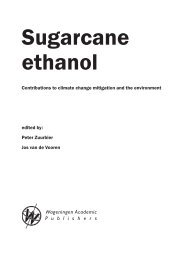Production and use of fuel ethanol in Brazil - BAFF
Production and use of fuel ethanol in Brazil - BAFF
Production and use of fuel ethanol in Brazil - BAFF
You also want an ePaper? Increase the reach of your titles
YUMPU automatically turns print PDFs into web optimized ePapers that Google loves.
52<br />
B4. Ethanol <strong>use</strong>: effect on vehicle <strong>and</strong> GHG<br />
(Greenho<strong>use</strong> Gas) emissions<br />
B4.1.<br />
What are the environmental benefits associated<br />
with the <strong>use</strong> <strong>of</strong> <strong>ethanol</strong>?<br />
Ethanol is a <strong>fuel</strong> produced from renewable sources <strong>and</strong> has low carbon content<br />
what makes possible the mitigation <strong>of</strong> greenho<strong>use</strong> gases (GHG). These two features<br />
attach strategic importance to it <strong>in</strong> the struggle aga<strong>in</strong>st the <strong>in</strong>tensification <strong>of</strong> the<br />
Greenho<strong>use</strong> Effect, as well as its effects on the global climate change, <strong>and</strong> put the<br />
product <strong>in</strong> l<strong>in</strong>e with the pr<strong>in</strong>ciples <strong>of</strong> susta<strong>in</strong>able development (see item B4.5).<br />
Compared to oil <strong>and</strong> its by-products, it features low toxicity <strong>and</strong> high biodegradability,<br />
which are factors <strong>of</strong> paramount importance <strong>in</strong> events <strong>of</strong> accidental spillage <strong>and</strong><br />
leakage <strong>of</strong> <strong>fuel</strong> on seashores, soils <strong>and</strong> surface <strong>and</strong> underground waters. This means<br />
that <strong>in</strong> the case <strong>of</strong> accidents the environmental impacts <strong>of</strong> <strong>ethanol</strong> will be substantially<br />
lower <strong>and</strong> the restoration <strong>of</strong> the environment will be much faster compared to what<br />
goes on <strong>in</strong> the case <strong>of</strong> fossil <strong>fuel</strong>s.<br />
Due to its high octane rat<strong>in</strong>g <strong>ethanol</strong> has been successfully replac<strong>in</strong>g toxic leadbased<br />
anti-knock additives. In terms <strong>of</strong> atmospheric emissions the <strong>use</strong> <strong>of</strong> <strong>ethanol</strong><br />
contributes to the reduction <strong>of</strong> such important pollutants as carbon monoxide (CO),<br />
sulphur oxides (SOx), particulate matter (PM) <strong>and</strong> several toxic organic compounds,<br />
such as benzene, toluene, xylene <strong>and</strong> 1-3 butadiene. In addition, several studies<br />
<strong>in</strong>dicate that the total emissions (volatile compounds <strong>and</strong> exhaust gas) show a lesser<br />
potential for formation <strong>of</strong> photochemical smog than those <strong>of</strong> gasol<strong>in</strong>e.<br />
B4.2.<br />
Is the emission <strong>of</strong> aldehydes due to the <strong>use</strong> <strong>of</strong><br />
<strong>ethanol</strong> a problem?<br />
As a matter <strong>of</strong> fact the <strong>in</strong>complete burn<strong>in</strong>g <strong>of</strong> <strong>ethanol</strong> <strong>in</strong> eng<strong>in</strong>es gives rise to<br />
aldehyde emissions, especially acetaldehyde. However, a fact that is not mentioned<br />
too <strong>of</strong>ten is that any other <strong>fuel</strong>s that can be <strong>use</strong>d <strong>in</strong> automotive applications<br />
(gasol<strong>in</strong>e, diesel, natural gas, liquefied petroleum gas, vegetable oils, biodiesel <strong>and</strong><br />
m<strong>ethanol</strong> – generate aldehydes as well <strong>of</strong>ten <strong>in</strong> worse conditions. It’s just a matter<br />
<strong>of</strong> remember<strong>in</strong>g that fossil <strong>fuel</strong>s generate large amounts <strong>of</strong> formaldehyde, a<br />
substance that is much more harmful than acetaldehyde to liv<strong>in</strong>g creatures <strong>and</strong> the<br />
B. Sugar-cane <strong>and</strong> <strong>ethanol</strong> production: environmental aspects












